
Operating Instructions
Mode d’emploi
Wireless Stereo
Headphone System
Sony Corporation © 1998 Printed in Japan
MDR-RF950RK
To recharge the headphones’ batteries
after use
To charge the batteries, follow steps above.
Since little electric current is used for charging,
there is no need to worry about overcharging.
Charging and using hours
* at 1 kHz, 1 mW + 1 mW output
** The hours required to fully charge empty batteries
Setting up the
headphones
1 Open the battery compartment lid on the
left outer side of the head band.
2 Insert two charged NC-AA-HJ batteries
by matching the ] and } on the
batteries to the ] and } in the battery
compartment.
3 Close the battery compartment lid.
Using the headphones with a commercially
available size AA (R6) dry batteries
Install the batteries in the manner as described in
“Setting up the headphones.”
Battery life
* at 1 kHz, 1 mW + 1 mW output
Notes on batteries
To avoid damage to the system caused by battery
leakage and corrosion;
– Install the batteries with the correct polarity.
– Do not try to recharge dry batteries.
– Remove the batteries if the system is not to be
used for a long period of time.
In case of battery leakage, wipe off any deposit in
the battery compartments before installing new
batteries.
Check the remaining power of the
headphones’ battery
Pull up the self adjusting band, and check that the
headphones’ power indicator lights in red. You
can now use the headphones.
Charge the battery or install a new dry battery, if
the power indicator light is weak or turned off and
the sound become distorted or has a lot of noise.
Notes
• During recharging, the transmitter is turned off.
• When the life of the rechargeable batteries are shortened
by half even after a proper recharging, replace them
with new NC-AA-HJ batteries.
( Operating the system
Listening to a program
1 First turn on the audio/video
equipment, then the transmitter.
2 Select the radio frequency with the
CHANNEL selector switch.
3 Put on the headphones and the power
turns on automatically.
4 Turn up the volume to a moderate level
with the VOL control, then tune the
headphones to the transmitte frequency
with the TUNING control until you can
hear the audio signal loud and clear.
1
2
Try the above steps 2 and 4 until the
receiving performance becomes better.
Sending RF signals from the Transmitter
The transmitter starts sending the RF signals
automatically, when the transmitter power is
turned on, and audio signals from the connected
equipment is detected.
If it does not detect an audio signal for more than
approximately five minutes, the transmitter will
stop sending RF signals.
But the Power indicator remains lighting. When
the transmitter receives an audio signal again, it
starts sending the RF signals.
If the audio signal is very weak, the transmitter
does not send RF signals automatically. In this
case, make sure the volume of the equipment
connected is set to 5 – 6.
You may not hear the beginning of the sound from
the headphones until the transmitter starts sending
the RF signals after detecting an audio signal.
Note
If the transmitter is connected to the headphones jack of
the source equipment, set the volume of that equipment as
high as possible without distorting the audio signal.
Auto power on/off function
When you remove the headphones, the power
turns off automatically. Do not allow the self
adjusting band to be pulled up, otherwise the
headphones will be switched on.
The power turns on. The power turns off.
Mute function
If a hissing noise is heard when the headphones
are used outside of the effective range (see the next
section), the mute function will be activated and
the sound will not be heard from the headphones.
To restore the sound, move near toward the
transmitter.
After listening to a program
Take the headphones off and rest them away on
the holder of the transmitter as shown below.
Note
Do not hang the headphones by the self adjusting band,
otherwise, the self adjusting band will be pulled up and
the headphones will be switched on.
The effective areas of
the transmitter
The optimum distance is up to approximately 150
feet (46 m) without the system picking up some
interference. However, the distance may vary
according to the surroundings and environment. If
the system picks up some noise while using it
within the above mentioned distance, reduce the
distance between the transmitter unit and the
headphones, or select the other channel.
Notes
• When you use the headphones inside the effective areas
of the transmitter, the transmitter can be placed in any
direction from the listener.
• Even within the signal reception area, there are some
spots (dead spot) where the RF signal can not be
received. This characteristics is inherent to RF signals,
and does not indicate malfunction. By slightly moving
the transmitter, location of the dead spot can be
changed.
Replacing the ear pads
When the ear pads become dirty or damaged, you
can get replacements from your Sony dealer.
Replace them as illustrated below.
1 Remove the old ear pad by pulling it out
of the groove on the housing.
2 Place the new ear pad on the driver unit
and insert the edge of the pad into the
groove as illustrated.
Make sure that the entire edge of the ear pad is
securely inserted into the groove.
( Additional information
Precautions
• When the headphones are not to be used for a
long period of time, remove the batteries to
avoid damage caused by battery leakage and
subsequent corrosion.
• When the transmitter is not to be used for a long
period of time, disconnect the AC power
adaptor from the AC outlet holding the plug.
Do not pull on the cord.
Also remove the batteries to avoid damage
caused by battery leakage and subsequent
corrosion.
• Do not leave the wireless stereo headphone
system in a location subject to direct sunlight,
heat or moisture.
Notes on headphones
Preventing hearing damage
Avoid using headphones at high volume. Hearing
experts advise against continuous, loud and
extended play. If you experience a ringing in your
ears, reduce the volume or discontinue use.
Caring for others
Keep the volume at a moderate level. This will
allow you to hear outside sounds and to be
considerate to the people around you.
If you have any questions or problems concerning
the system that are not covered in this manual,
please consult the nearest Sony dealer.
Be sure to bring the headphones and the
transmitter to the Sony dealer when requiring
repair work.
2 Connect the transmitter to an AC outlet
using the supplied AC power adaptor.
Notes
• Use only the supplied AC power adaptor. Do not use
any other AC power adaptor.
Polarity of the plug
• When you connect the connecting cord directly to an
earphone jack, the audio signal will not be output
through the right channel. In such a case, use the
separately sold PC-236HG plug adaptor.
• If the connected equipment has the AVLS (Automatic
Volume Limiter System) function, be sure to turn the
function off when using the transmitter. Otherwise, you
will have to turn up the volume of the headphones, and
that may cause noise.
• Do not place the transmitter near a fluorescent lamp, etc.
when using the system.
* WALKMAN is a registered trademark of Sony
Corporation.
Charging the
headphones’ batteries
Using the headphones for the first time
The headphones are powered by either supplied
rechargeable batteries or commercially available
size AA (R6) batteries.
When you use the headphones with the supplied
rechargeable batteries NC-AA-HJ for the first time,
charge the batteries in the following manner.
NC-AA-HJ is applicable only for Sony cordless/
wireless headphone systems. Never use for any
other purpose.
1 Press the OPEN button to open the
battery compartment lid of the
transmitter.
2 Insert two NC-AA-HJ batteries supplied
by matching the ] and } on the
batteries to the ] and } in the battery
compartment.
3 Close the battery compartment.
4 Connect the transmitter to a power
source.
5 Press the OFF/CHG•POWER ON
switch so that the OFF/CHG indicator
lights up green.
Charging starts.
Notes
• Charge only the supplied rechargeable batteries
NC-AA-HJ.
• You cannot recharge other size AA (R6) rechargeable
batteries (NC-AA etc.) with this unit.
• Be sure to charge both the rechargeable batteries at a
time. The charger cannot charge the batteries one by
one.
• Use only the supplied AC power adaptor. Do not use
any other AC power adaptor.
Polarity of the plug
If the indicator is not lit
Check that the supplied rechargeable batteries are
correctly inserted in the battery compartment of
the transmitter.
Setting up the
transmitter
1 Connect the transmitter to audio/video
equipment. Select one of the hookups
below depending on the jack type:
a To connect to a headphones jack
b To connect to LINE OUT or REC OUT
jacks
c To connect to TV, etc.
If noise occurs when the transmitter is
connected to the headphone jack of your
TV or VCR, set the NOISE FILTER switch
to ON.
Notes
• If you connect the transmitter to LINE OUT or REC
OUT jack, do not set the NOISE FILTER switch to
ON. Otherwise, the volume will be limited.
• The NOISE FILTER switch effects the sound only in
cases such as connection diagram c. In diagrams
a and b, the switch has no effect.
• When the transmitter is placed on or near a TV, it
may pick up a noise. In such case, place the
transmitter away from the TV.
Notes on receiving
performance
The system for this equipment utilizes very high
frequency signals in the 900 MHz band so the
receiving performance may deteriorate due to the
surroundings. The following examples illustrate
conditions that may reduce the possible receiving
range or cause interference with reception.
• Inside a building with walls containing steel
beams.
• Area with many steel file cabinets, etc.
• Area with many electrical appliances capable of
generating electromagnetic noise.
• Transmitter is placed on a metal instrument.
• Area facing roadways.
• Noise or interfering signals exist in the
surroundings due to radio transceivers in trucks,
etc.
• Noise or interfering signals exist in the
surroundings due to wireless communication
systems installed along roadways.
( Getting started
Unpacking
Check that you have the following items:
• The transmitter
• Ni-Cd rechargeable batteries NC-AA-HJ
• AC power adaptor
• The headphones
• Unimatch plug adaptor (stereo mini jack n
stereo phone plug)
• Connecting cord (phono plugs ˜ stereo mini
plug), 1 m
English
Note
This device complies with RSS-210 of Industry
Canada. Operation is subject to the following two
conditions: (1) this device may not cause
interference, and (2) this device must accept any
interference, including interference that may cause
undesired operation of the device.
For the customers in the Canada
RECYCLING NICKEL-CADMIUM BATTERIES
Nickel-Cadmium batteries
are recyclable. You can help
preserve our environment by
returning your unwanted
batteries to your nearest
point for collection, recycling
or proper disposal.
Note: In some areas the disposal of nickel-
cadmium batteries in household or
business trash may be prohibited.
RBRC (Rechargeable Battery Recycling
Corporation) advises you about spent battery
collection by the following phone number.
Call toll free number: 1-800-822-8837 (United
States and Canada only)
Caution: Do not handle damaged or leaking
nickel-cadmium batteries.
Transmitter
Left channel
(white)
Right channel
(red)
Unimatch plug
adaptor
(supplied)
Discman, MD,
WALKMAN*, VCR,
etc.
to headphones
jack (stereo
mini jack)
Connecting cord
(supplied)
to AUDIO IN
A jacks
to headphones
jack (stereo
phone jack)
TV, etc.
to stereo mini jack
Transmitter
to AUDIO IN
A jack
Left channel
(white)
Right channel
(red)
Connecting cord
(supplied)
Transmitter
to AUDIO IN
B jack
Connecting cord
(supplied)
Right channel
(red)
Left channel
(white)
to LINE OUT or REC
OUT jacks
Stereo system, VCR, etc.
Transmitter
to an AC outlet
To DC IN
9 V jack
AC power adaptor (supplied)
Approx. charging
hours
1
24**
Approx. using time*
50 minutes
20 hours
Self adjusting band
Holder
No sound/Muffled sound
/ Turn on the transmitter first, then put on the
headphones.
/ Check the connection of the audio/video
equipment or the AC power adaptor.
/ Check that the audio/video equipment is turned
on.
/ Turn up the volume on the connected audio/
video equipment, if the transmitter is connected
to the headphones jack.
/ Select the radio frequency with the CHANNEL
selector, then tune in the frequency of the
transmitter with the TUNING control.
/ The mute function is activated.
Use the headphones near the transmitter.
/ The headphones’ POWER indicator light is weak
or turned off.
•Charge the rechargeable batteries or if the
POWER indicator is still off after charging the
batteries, replace them with new
NC-AA-HJ batteries.
•If you are using the conventional dry batteries,
replace it with new ones.
/ If you connect the transmitter to LINE OUT or
REC OUT jack of an audio reproducer, make sure
that the NOISE FILTER switch is set to OFF.
Distortion
/ If the transmitter is connected to the headphones
jack, turn down the volume of the connected
audio/video equipment.
/ Select the radio frequency with the CHANNEL
selector.
/ The headphones’ POWER indicator light is weak
or turned off.
•Charge the rechargeable batteries or if the
POWER indicator is still off after charging the
batteries, replace them with new
NC-AA-HJ batteries.
•If you are using the conventional dry batteries,
replace it with new ones.
/ If you connect the transmitter to LINE OUT or
REC OUT jack of an audio reproducer, make sure
that the NOISE FILTER switch is set to OFF.
Loud background noise
/ Move closer to the transmitter. As you move
away from the transmitter, more noise is likely to
be heard.
/ If the transmitter is connected to the headphones
jack, turn up the volume of the connected audio/
video equipment.
/ Select the radio frequency with the CHANNEL
selector, then tune in the frequency of the
transmitter with the TUNING control.
/ The headphones’ POWER indicator light is weak
or turned off.
•Charge the rechargeable batteries or if the
POWER indicator is still off after charging the
batteries, replace them with new
NC-AA-HJ batteries.
•If you are using the conventional dry batteries,
replace it with new ones.
/ If you connect the transmitter to LINE OUT or
REC OUT jack of an audio reproducer, make sure
that the NOISE FILTER switch is set to OFF.
The batteries cannot be charged.
/ The dry batteries are installed.
•Install the supplied rechargeable batteries.
/ The rechargeable batteries other than NC-AA-HJ
are installed.
•Install NC-AA-HJ rechargeable batteries.
Incapable of the tuning
/ Turn up the volume moderately, then tune in the
frequency.
Specifications
General
Carrier frequency
913.0 – 915.0 MHz
Channel Ch1, Ch2, Ch3
Modulation FM stereo
Frequency response
18 – 22,000 Hz
Transmitter
RF power Less than 94 dBµV/m at 3 m
Power source DC 9 V: supplied AC power adaptor
Audio input phono jacks/stereo mini jack
Dimensions Approx. 120 mm dia × 290 mm
(4
3
/
4
× 11
1
/
2
in.) (w/h)
Mass Approx. 155 g (5.5 oz.)
Headphones
Power source DC 3 V: 2 × R6 (size AA) battery or
2 × supplied
NC-AA-HJ Ni-Cd
rechargeable battery
Mass Approx. 265 g (9.4 oz.) incl.
Ni-cd batteries
Supplied Ni-Cd rechargeable batteries
Model name NC-AA-HJ
Voltage 1.2 V
Capacity 600 mAh
Optional accessories
Ni-Cd rechargeable battery
NC-AA-HJ
Plug adaptor PC-236HG (stereo mini jack ˜
monaural mini plug)
Design and specifications are subject to change without
notice.
Troubleshooting
Battery
Sony alkaline battery SG (LR6)
Sony battery SR (R6P)
Approx. hours*
60
30
Welcome!
Thank you for purchasing the Sony
MDR-RF950RK Wireless Stereo Headphone
System. Before operating the unit, please read this
manual thoroughly and retain it for future
reference.
Some features are:
• Wireless system that allows you to listen to a
program free from the restriction of a cord
within 150 feet (46 m) from the transmitter.
• High fidelity sound reproduction
• Compact transmitter which operates on AC
power using the supplied AC power adaptor
and which also functions as battery charger.
• Comfortable Supra-aural headphones with self
adjusting head band
• Automatic ON/OFF function on headphones to
preserve battery power
• Mute function to avoid noise when no audio
signal is available.
• Either supplied rechargeable batteries or
commercially available size AA (R6) dry
batteries are used for the power source of the
headphones.
3-864-034-22(1)
TUNING
Control
VOL
Control

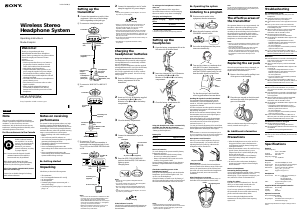



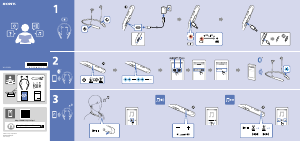
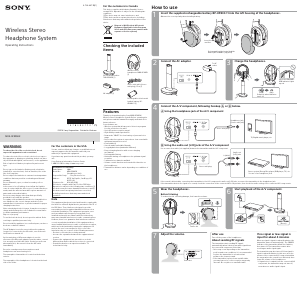
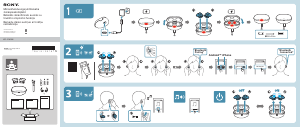
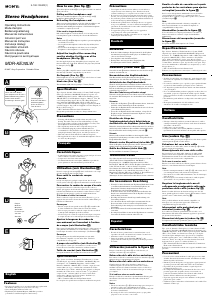
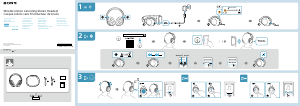
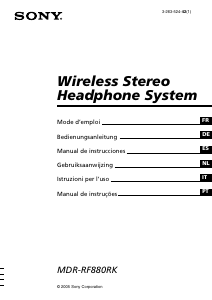
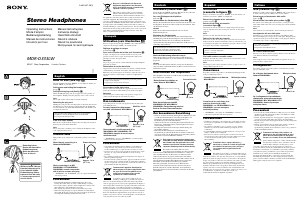
Praat mee over dit product
Laat hier weten wat jij vindt van de Sony MDR-RF950RK Koptelefoon. Als je een vraag hebt, lees dan eerst zorgvuldig de handleiding door. Een handleiding aanvragen kan via ons contactformulier.